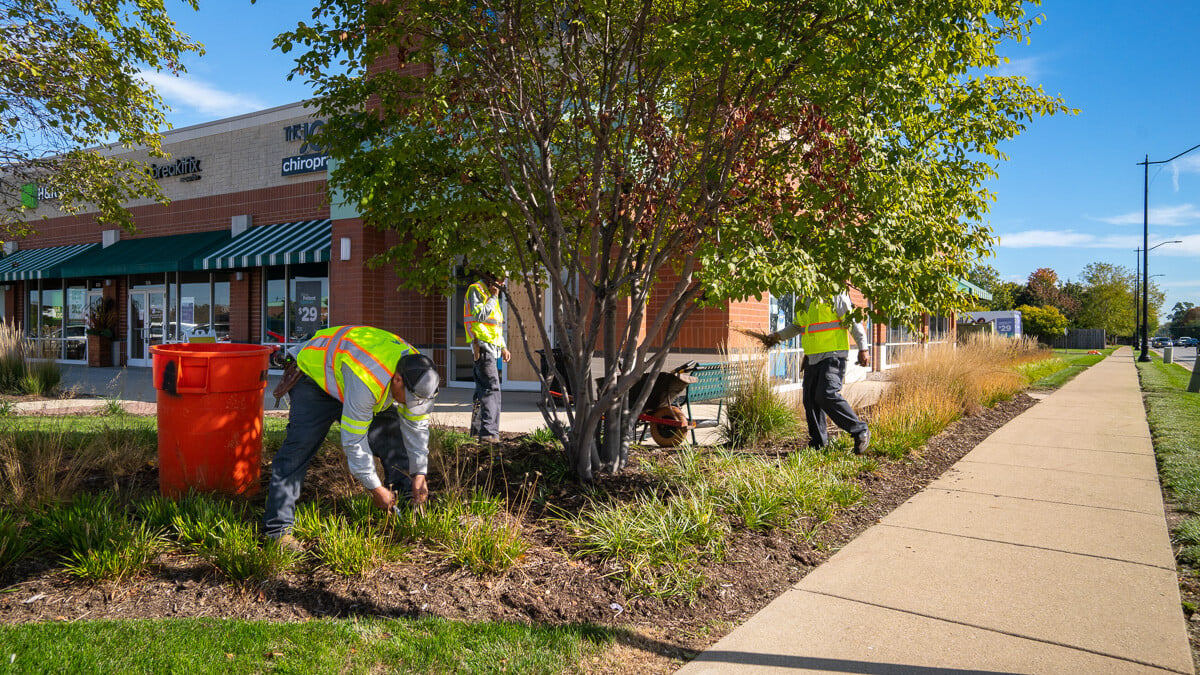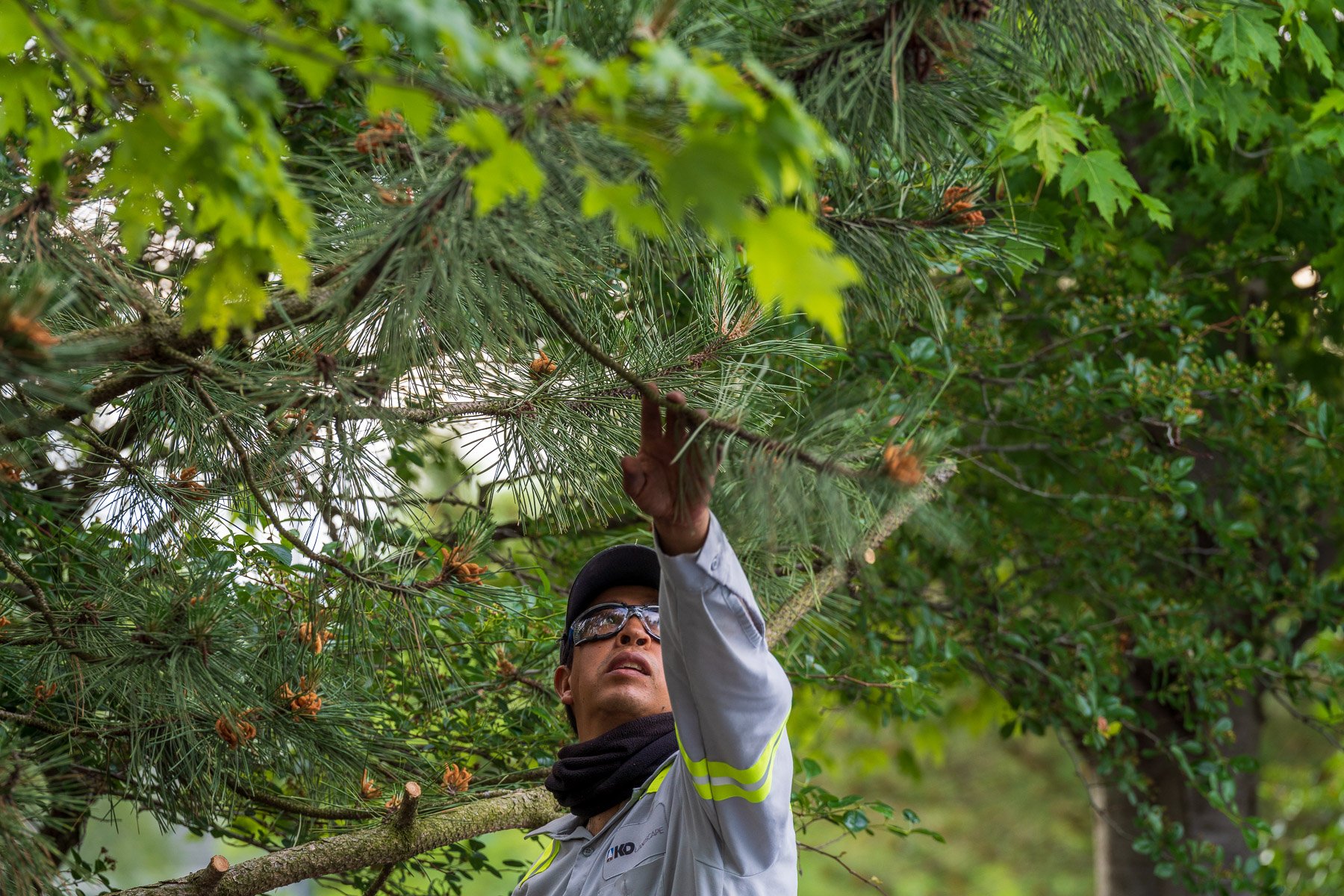Maintaining a healthy commercial landscape in Greater Chicago involves more than just visual appeal; it focuses on fostering an ecosystem where trees and shrubs can prosper.
Proper care for trees and shrubs in Chicago not only increases the value of your property but also supports the overall health of your environment.
Table of Contents
- Why Tree & Shrub Care Matters for Commercial Properties in Chicagoland
- Choosing the Right Trees and Shrubs for Chicagoland’s Climate
- Tree and Shrub Planting Best Practices: Ensuring Strong Roots
- Pruning Techniques for Healthy Growth and Aesthetic Appeal
- Seasonal Tree and Shrub Care: Managing Chicago’s Climate Extremes
- Disease and Pest Management for Chicago's Trees and Shrubs
- Long-Term Tree and Shrub Maintenance Plans for Chicagoland Properties
- Trust Your Commercial Tree & Shrub Care to the Professionals at KD Landscape
Trees and shrubs are vital components of our natural environment, providing shade, improving air quality, and creating habitats for a wide range of wildlife. However, ensuring their health demands more than just occasional watering and pruning.
In this guide, we’ll discuss commercial plant health care as an integral part of your commercial landscape maintenance in Chicagoland.
Why Tree and Shrub Care Matters for Commercial Properties in Chicagoland
Trees and shrubs add tremendous value to any business.
And caring for them requires proper landscape maintenance that keeps those landscape assets working for you rather than against you.
These are the benefits commercial plant healthcare delivers for your facility.
Improved Curb Appeal
Well-maintained trees and shrubs enhance curb appeal, helping businesses maximize their visual impact.
Plants that receive proper care for trees and shrubs make your property look inviting and demonstrate that your business values its outside appearance, which in turn gives your customers and visitors a more positive impression of the maintenance and upkeep inside your facility.
A property with unkempt trees and shrubs could lead potential customers to think you’re unorganized and unreliable. Curb appeal builds trust, increases visibility, draws people in, and helps your company stand out from competitors.
Better Plant Health
When you invest in commercial plant health care for trees and shrubs, you ensure you have healthier, happier plants.
Plants that are properly pruned and fertilized experience less stress and fewer pest and disease infestations.
Lower Replacement and Maintenance Costs
Trees and shrubs are significant investments on your commercial site. They are larger investments than your lawn, even though it can seem more expensive.
A lawn, for instance, is easy to regrow in a short amount of time for a minimal cost, while trees and shrubs take years to mature and cost much more to remove and replace.

This means commercial plant health care is crucial to protect these assets. Preventing problems ensures your investments last a long time and continue to deliver great color, shade, and interest for your customers, tenants, and visitors.
Well-cared-for plants also incur fewer maintenance costs because they experience fewer problems.
Reduced Need to Remove and Replace Trees and Shrubs
In addition to being expensive, trees and shrubs require a bigger effort to remove and replace.
Removing large trees or shrubs means you have to deal with this area being off-limits to people moving around on your commercial property while you hire a professional to help dig out the larger plant and then install a new one.
Then, instead of having the instant shade or positive visual impact that your previous plant provided, you have to wait for a new, young plant to fill the space that was once occupied by a fully grown one.
Proper tree and shrub care in Chicago can help you avoid this hassle.
Fewer Safety Hazards
Safety is a key component of maintaining both the interior and exterior of your commercial facility in Greater Chicago. You want to keep your property neat and clean to make employees and visitors feel safe and maintain a positive reputation in your local community.

Proper commercial pruning in Chicago helps increase visibility, which enhances safety. It also provides thieves or criminals with fewer places to hide, thereby reducing crime.
This can also help decrease your costs by saving you fines and liability claims that can result from someone getting hurt on your site due to a fallen tree branch or a poorly visible area caused by overgrown plants.
Boosted Property Value
The overall value of your commercial site can also receive a significant boost when you invest in commercial plant healthcare for trees and shrubs.
Not only does your commercial facility’s marketability shine, but its perceived value also rises due to this well-maintained appearance.
Choosing the Right Trees and Shrubs for Chicagoland’s Climate
Too frequently, commercial facilities will choose the wrong tree or shrub for the wrong place.
Soil conditions, traffic, sunlight, and water or drainage in an area guide you on which species might thrive best there. Additionally, you need to consider the specific habits of each tree or shrub, including their growth expectations, sunlight and water requirements, soil preferences, and fruiting or flowering characteristics.
Aligning the conditions with the plants' needs will produce optimal results for long-term landscape durability and aesthetics.
These sturdy trees can meet your various property needs while being low-maintenance.
Flowering Trees
When you’re seeking enhanced curb appeal for businesses in Chicagoland, you're looking for a hardy variety that can withstand urban stressors like road salt, compacted soil, wind, and fluctuating temperatures.

You also want plants that are low maintenance, in addition to those that offer seasonal interest with flowers, interesting bark, and fall color.
It’s not too much to ask for, right? Try these reliable varieties:
Eastern Redbud
In early to mid-spring, the eastern redbud tree bursts into bloom with rosy, pea-sized flowers that emerge from fuchsia buds along its branches before the leaves appear in burgundy.
In fall, its heart-shaped leaves turn a buttery, golden yellow. The eastern redbud can reach 20 to 30 feet tall with a spread of 25 to 35 feet at maturity. This sturdy, flowering tree remains hardy down to -20 degrees Fahrenheit.
%20CC.jpg?width=4288&height=2848&name=Cercis%20canadensis%20(Eastern%20Redbud)%20CC.jpg)
Plant this tree in full sun or partial shade. And if you’re looking for a small flowering tree to add to your commercial site, try the ‘Ruby Falls’ Eastern redbud, which is a dwarf cascading variety that delivers small purple flowers.
Thornless Honeylocust
If you want a fast-growing tree to plant in Illinois with fragrant spring flowers, the thornless honeylocust is a good choice.
The open silhouette is full of tiny leaves that turn yellow in autumn. In spring, the blooms are yellow and fragrant. This sun-loving tree can grow to a height of between 30 and 70 feet, with a 50-foot spread, and can tolerate a wide range of soils.
Additionally, Thornless Honeylocust is tolerant of various stressors, including pollution, road salt, and drought. This tree’s thin, airy crown provides dappled shade underneath.
Serviceberry
Generally resistant to many diseases, this tree also offers ornamental value. Typically growing to a height of 15 to 25 feet with a 15- to 20-foot spread, the serviceberry has green leaves in summer that turn yellow, orange, or red in fall.
Its spring flowers are white or pale pink, and its berries are deep purple, attracting birds.
Drought-Tolerant Trees
Hot weather and dryness in the summer months can negatively impact the plants in your commercial landscape. Drought-resistant commercial landscaping is one way to beat the heat.
Ideally, selecting native plants for commercial landscape projects can be highly effective. Try one of these options:
Eastern Redcedar
This resilient evergreen tree tolerates drought, heat, wind, and poor soil conditions. The Eastern redcedar’s foliage is vibrant, bluish-green.
%20CC.jpg?width=4000&height=3000&name=Eastern%20Redcedar%20(Juniperus%20virginiana)%20CC.jpg)
You can expect this tree to grow 30 to 65 feet high with an 8- to 25-foot spread. Its dense, pyramidal shape becomes more columnar as it grows, making an attractive addition to any landscape year-round.
It is highly resistant to pests and diseases.
Silver Maple
Known for its large size, distinctive leaves, and adaptability, the silver maple can reach heights of 50 to 80 feet with a spread of 35 to 50 feet.
A fast-growing shade tree, this tree features light green leaves with silver undersides. It delivers a pale yellow fall color on smooth, gray bark.
Colorful Shrubs
Looking for some shrubs to bring some dimension to your commercial landscape now that you have your trees in place? Consider these varieties, which are strong performers in the Greater Chicago area, and incorporate them into functional landscape designs for high-traffic areas.
Beautyberry
This drought-tolerant shrub has eye-catching berries that add pops of color to a commercial landscape. It grows to about 3 to 4 feet high, making it ideal for borders or as a companion plant in an entryway bed.
In the spring and summer, beautyberry features small, delicate pink or lavender flowers that attract butterflies. Then, in the fall, the leaves begin to turn yellow and drop, and clusters of vivid, metallic-purple berries emerge.
These berries persist into winter, providing visual interest.
Red Twig Dogwood
This versatile, deciduous, drought-tolerant shrub brings year-round beauty to Chicago commercial landscapes.
.jpg?width=2948&height=2479&name=red%20twig%20dogwood%20(CC).jpg)
Best known for its striking red twigs in winter, this hardy, low-maintenance shrub can grow 7 to 9 feet tall and wide, forming a dense, multi-stemmed shrub that offers structure. In the spring and summer, the Red Twig Dogwood showcases lush green foliage and clusters of small white flowers, which give way to white or blue-tinged berries that attract birds.
Come autumn, the leaves transition to a warm, reddish-purple hue before falling, revealing the shrub’s signature bright red stems.
Tree and Shrub Planting Best Practices: Ensuring Strong Roots
Planting a new tree or shrub in your commercial landscape can be a great feeling. It will add color and texture to your highly trafficked site, elevating your business value and curb appeal.
However, planting trees and shrubs properly and taking great care of them are what ensure they deliver gorgeous blooms, lush greenery, and numerous positive benefits.
Let’s discuss how commercial plant healthcare from the planting phase can provide them with great beginnings, enabling them to deliver long-lasting impacts.
Mulching Newly Planted Trees & Shrubs
Mulch is one of the simplest yet most effective additions you can make after planting a tree or shrub, offering a wide range of benefits in one easy step.
Mulch helps your trees and shrubs retain moisture. It also maintains even soil moisture while suppressing those annoying weeds.

KD Landscape applies 2 to 3 inches of organic, shredded, hardwood mulch around your plant’s drip zone (the width of the shrub or the tree’s crown).
Ensure mulch is placed approximately 1 to 2 inches away from tree trunks to promote good air circulation and prevent 'volcano mulching', which can lead to trunk decay or pest and disease infestations.
Tree Pruning and Shrub Trimming for Young Plants
It’s very important to prune young trees and shrubs properly to ensure they grow strong and healthy plants.
While having many strong branches is excellent, it’s always best for a tree to have a main leader so it can maintain a strong, stable structure. Commercial pruning in Chicago, performed by a reputable service provider, removes competing branches, allowing the leader to grow.
Tree and shrub pruning also removes any dead branches or branches that cross and rub against each other.
You never want to remove more than 15% of a plant's canopy at any one time, and your commercial grounds maintenance professional can ensure this is done properly each year.
Fertilizing Newly Planted Trees & Shrubs
To keep your trees and shrubs healthy, annual fertilization is recommended.
You should also ensure that you use a slow-release fertilizer, allowing nutrients to be distributed evenly over time. Spring or fall is an ideal time for this application.
Watering Newly Planted Trees & Shrubs
Moisture is essential for new plants.
Water new trees and shrubs every other day during the first two weeks. Then, water new trees and shrubs once weekly during the first year. Your commercial landscaper in Chicago will ensure your irrigation system is on this schedule.
They will also take into account rainfall, ensuring your soil drains and dries between waterings.
During periods of drought, water twice weekly during the first year of a tree or shrub’s life.
Monitoring Early Tree and Shrub Health
As your tree or shrub grows, your commercial landscaper in Chicago will look for any red flags, including:
- Discoloration: Yellow or brown leaves on your plant during any season other than fall, as well as black or white spots, could be signs of a problem.
- Leaf drop or wilt: You shouldn’t see early leaf drop or wilt appearing as curled or scorched leaves in spring or summer.
- Dieback of twigs and branches: Branches with dead leaves will be removed; however, if this occurs in large chunks or repeatedly, it could be a sign of poor plant health.
Pruning Techniques for Healthy Growth and Aesthetic Appeal
Pruning serves multiple purposes in commercial landscape maintenance in Chicagoland.
It helps shape and define the visual appearance of trees and shrubs, creating a neat and manicured look that enhances the property's overall aesthetic appeal.

Pruning also promotes air circulation and sunlight penetration within the tree canopy, reducing the risk of disease and pest infestations. By removing dead or diseased branches and encouraging new growth, pruning rejuvenates plants and stimulates vigorous, healthy growth.
These pruning techniques we practice at KD Landscape ensure success.
The Right Tools
Proper pruning tools include high-quality pruning shears, loppers, pruning saws, and pole pruners, all of which are suitable for the size and type of plants on your site.
Sharp, well-maintained tools ensure clean cuts and minimize stress on plants, promoting faster healing and reducing the risk of disease transmission.
Deadheading
Remove spent flowers from annuals, perennials, and flowering shrubs to encourage continuous blooming throughout the summer months is one aspect of enhanced curb appeal for businesses.
Thinning and Shaping
Thinning out dense canopies of trees to improve air circulation and reduce wind resistance mitigates the risk of storm damage.
This process involves removing crossing or rubbing branches, water sprouts, and suckers to maintain a well-balanced and structurally sound canopy.
Selective Shrub Pruning
Your commercial landscape professional will prune shrubs to maintain desired size and shape, removing overgrown or leggy branches to promote dense, compact growth.

Your shrubs can maintain their natural form by removing any damaged, diseased, or dead wood. But your service provider will have flowering shrubs on a specific schedule to avoid cutting off next year's flower buds.
Training Plants
Another technique involves pruning selectively to encourage upward growth and prevent overcrowding.
Renovation Pruning
For neglected or overgrown commercial landscapes, KD Landscape will perform renovation pruning to rejuvenate plants and restore their health and vigor.
To achieve this, we gradually remove overgrown or damaged branches over multiple seasons, minimizing stress on the plants and promoting gradual recovery.
Seasonal Tree and Shrub Care: Managing Chicago’s Climate Extremes
You want to keep your commercial property looking its best at all times of the year with long-term landscape durability and aesthetics.
However, you may not know which commercial plant healthcare services your trees and shrubs require and at what specific times of year they need them.
commercial%20HOA%20planting%20bed%20with%20mulch%20lawn%20grasses%20ornamental%20tree.jpg?width=1620&height=1080&name=kdlandscapeinc.comhubfsImages%20-%202024%20Summer%20Shoot%20(HOA)commercial%20HOA%20planting%20bed%20with%20mulch%20lawn%20grasses%20ornamental%20tree.jpg)
Although there is some overlap, many of the services KD Landscape performs have a specific timeline for optimal benefit to your commercial facility. And it’s essential to have year-round landscape services because they maintain your property's aesthetics, help you stay within your budget, and keep goals and renovation tasks on track.
This calendar will help you keep your trees and shrubs happy and healthy year-round.
January - March
January is an excellent time for planning commercial landscape design with sustainable materials. This may involve some necessary renovations on your site or the creation of a newly designed area. Your commercial landscape partner can help you focus on areas that make the most sense to increase the positive attributes of your facility.
In February, a dormant oil application can help manage small but challenging pests, such as aphids, mites, and scales. This natural product helps prevent and manage these tiny pests. Since these pests are more likely to survive the winter, dormant oil protects your plants before they emerge from dormancy, making this the perfect time of year to combat them.
By March, the growing season begins, depending on the weather. A thorough inspection of all trees and shrubs as they emerge can help us identify any early problems, allowing us to address them promptly.
April - August
Now is the time to fertilize your trees, shrubs, and native plants for commercial landscape projects. It provides your plants with the essential nutrients they need to grow strong and bloom. A pre-emergent herbicide application at this time will also help control pesky spring and early summer weeds in your landscape beds.
May is the ideal time for applying mulch, which significantly enhances the value of your commercial landscape beds. It suppresses weeds, maintains even soil temperature and moisture, and adds important organic matter back into the soil as it breaks down. The ideal mulch application is approximately 2 inches of double-shredded hardwood mulch.
In June and July, your commercial landscaper in Chicago needs to adjust irrigation based on heat, drought, and rainfall. Adjusting irrigation systems throughout the year helps us meet your plants’ water needs adequately.
September - December
Fall fertilization and commercial pruning in Chicago are essential in September and October, depending on the type and condition of your plants. Fall fertilization targets root growth, and fall herbicides continue to tackle those late-emerging weeds.
Then, before winter arrives, you want to ensure that you have done a thorough leaf cleanup from the fall.
Raking up the leaves or blowing them into piles and disposing of them or removing them keeps your commercial landscape beds looking fresh, while also preparing your commercial site for winter. This is so important because leaves that are left can cause diseases in plants.
.jpg?width=2048&height=1365&name=winter%20plant%20pot%20snow%20(1).jpg)
December is the time for dormant pruning. When all of the leaves have fallen off your deciduous plants and shrubs, it’s much easier to see the tree’s structure while trimming and identifying broken, dead, and dying branches. Dormant pruning also causes less stress on the plant and allows for robust new growth the following spring.
Anti-desiccant sprays can also help evergreens resist winter moisture loss – a common problem in cold climates, such as those in Chicagoland commercial landscapes. This spray applies a thin coating to plant needles or leaves, reducing water loss through transpiration and helping to prevent winter burn or browning.
Disease and Pest Management for Chicago's Trees and Shrubs
Identifying trees and shrubs in decline in your commercial landscape can be a significant blow to your reputation and business budget.
This is because the beloved magnolia or the prized oak may have taken years to grow to the ideal height. It might fit perfectly in this specific spot in your landscape, highlighting a path or entranceway.
And now you're seeing its dying branches and leaves, or a sickly appearance, and wondering if you’ve lost a beautiful feature in your landscape that draws in customers, offers shade, or is an excellent backdrop for people to rest or take photos.
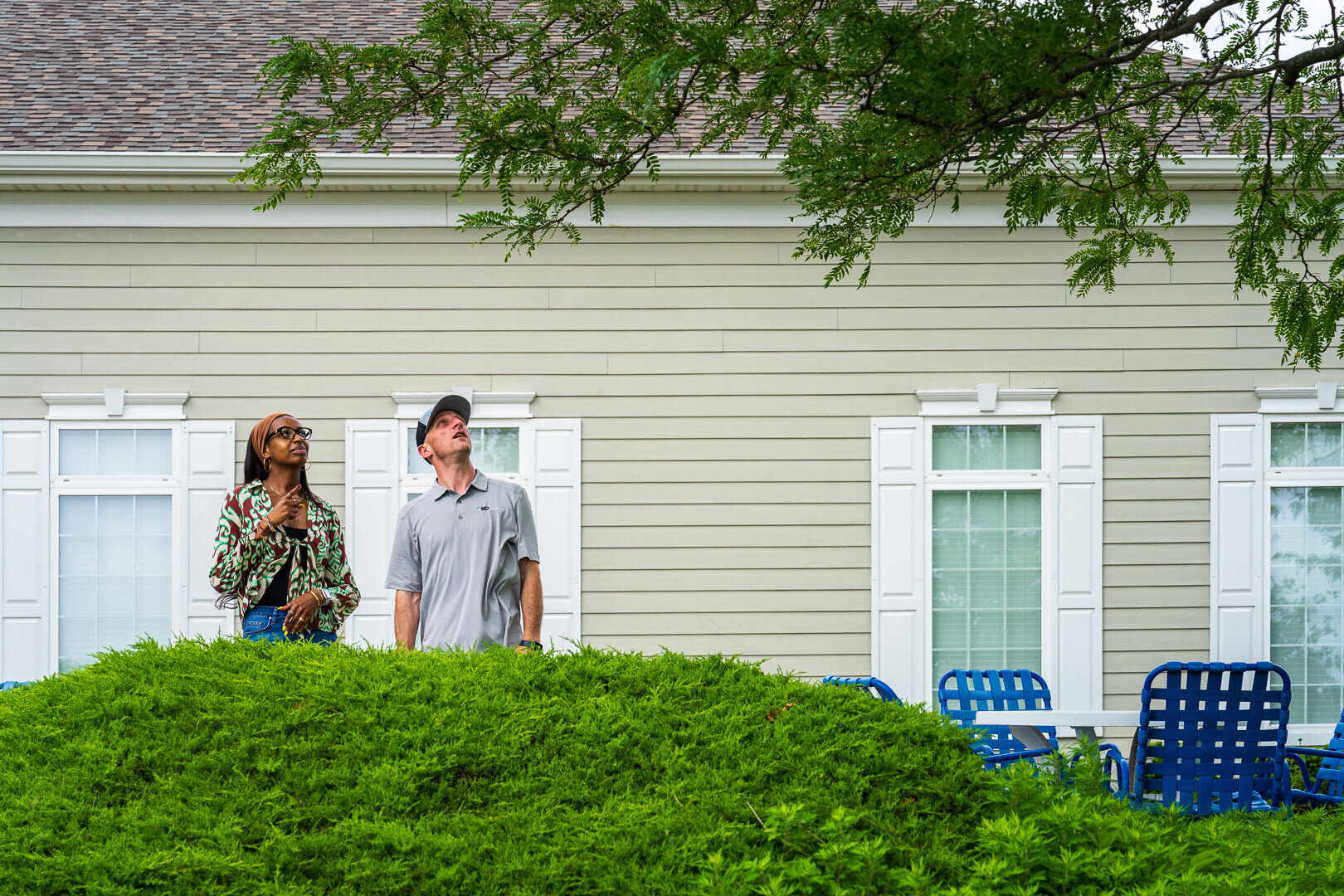
This is where neglected trees and shrubs can let you down. Not only do they look bad, but they can also suffer from more extreme issues. Let’s talk about some of the more extreme situations you might face when it comes to not following a full, annual commercial plant health care plan.
Elevated Pest and Disease Pressure
A weak plant that lacks care can be more susceptible to pest and disease infestations. And that’s when the real trouble begins.
The most common signs of pest issues from the lack of commercial plant health care are discolored leaves and needles, spots or holes on leaves, or drooping branches and dropping needles from evergreens.
Your commercial landscape professional will identify the pest or disease problem and assess the level of damage and treat it appropriately or advise you of next steps. Staying ahead of these issues ensures they can be managed and your tree or shrub can be saved.
Increased Structural Weaknesses, Property Damage, and Liability Risks
Overgrown or weak trees and shrubs are also more likely to cause damage to commercial properties, negatively impacting the long-term durability and aesthetics of the landscape.
Pests and diseases left unchecked can also exacerbate these weaknesses. Dead or dying wood attracts insects and fungi. They can use the dead wood as an entry point and then spread to healthy parts of the tree.
Then, compromised limbs can increase the risk of falling branches. All it takes is one heavy snow, ice, or windstorm, and a weak or pest-infested limb can fall onto roofs, cars, or power lines.
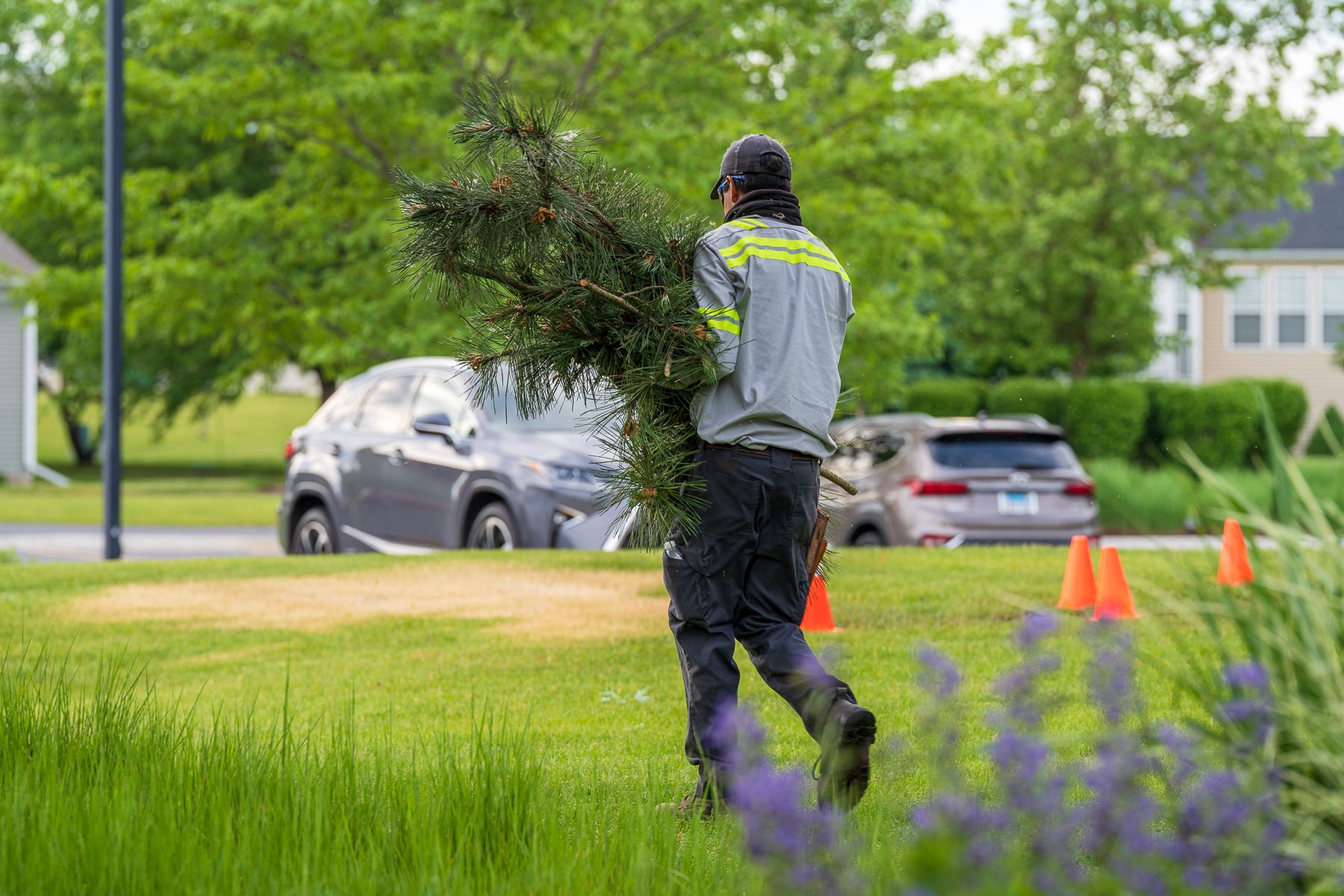
Unchecked tree roots can even grow into concrete and disrupt walkways, leading to trip-and-fall hazards.
All of these issues can increase your liability risks, leading to unnecessary replacement costs.
How can you prevent these problems? Commercial plant healthcare, including regular and proper pruning and annual fertilization, can prevent your trees and shrubs from developing into a situation where they cause damage.
Pests and Diseases Can Reduce Tree and Shrub Lifespans
Without proper commercial plant health care, trees and shrubs become more susceptible to nutrient deficiencies, root rot, pest infestations, and disease outbreaks.
Certain pest infestations can decrease a tree’s lifespan. Invasive pests, such as the emerald ash borer, can kill ash trees in two to six years, according to the University of Illinois Extension.
Looking for signs of pest or disease infestations and treating plants promptly ensures they can better survive these invaders and extend their lifespans, allowing them to continue delivering benefits on your commercial property.
Long-Term Tree and Shrub Maintenance Plans for Chicagoland Properties
When you’re looking for a landscape maintenance partner for commercial plant health care, you hope that you’ll find someone you can work with for the long haul.
You want to find a company you can trust that won’t let you down. You want the best price. You want a top-quality service. You don’t want headaches. You want to know that things will get done when they need to, and that you won’t have to micromanage something you hired a professional to handle.
We get it. Anyone in your position would want the same.
But there are multiple options when signing a commercial landscape maintenance contract. And understanding them can help you make the best decisions for you and your business.

Typical contracts last from one to three years. One-year agreements typically need to be renewed annually, whereas a three-year agreement is considered a more long-term commitment.
There are definite pros and cons of long-term agreements for your tree and shrub health, including:
Relationship Building
When you opt for a short-term contract, the process often feels transactional. This means that you may not be building a deeper relationship, where you can get to know your contractor and they can become familiar with the specifics of your site.
Over multiple years, a contractor gets to learn about your site, watching it go through multiple growing seasons and weather conditions. This process can reveal weak areas or trouble spots that become targets for improvement.
Better Budgeting and Planning
A long-term contract can lock in a price, so you won’t have any cost surprises. This also means you can plan how you will use these dollars.
Perhaps you need to plant new trees or renovate an area; for instance, then you can phase out that renovation strategy and the associated costs over time.

This could enable you to tackle a bigger project that you have always wanted to address but never had the chance to with the limitations of just your annual budget.
Save Time on Annual RFPs
By the time you decide on a commercial plant health care partner, you are already close to going through the bidding process again. A long-term contract saves you the time of putting out RFPs and reviewing, analyzing, and responding to bids every year.
Trust Your Commercial Tree & Shrub Care to the Professionals at KD Landscape
The long-term benefits of a commercial plant health care program are substantial. Over time, a well-maintained facility landscape with healthy plants will require less intensive care, as strong, healthy plants are more resistant to pests and diseases. This can lead to reduced maintenance costs and a lower need for treatments.
Moreover, a thriving landscape contributes to the overall health of the ecosystem. Healthy trees and shrubs improve air quality, reduce soil erosion, and provide habitats for wildlife, while also boosting your property value and enhancing curb appeal. Investing in a commercial plant health care program means you are also investing in the environmental sustainability of your property.
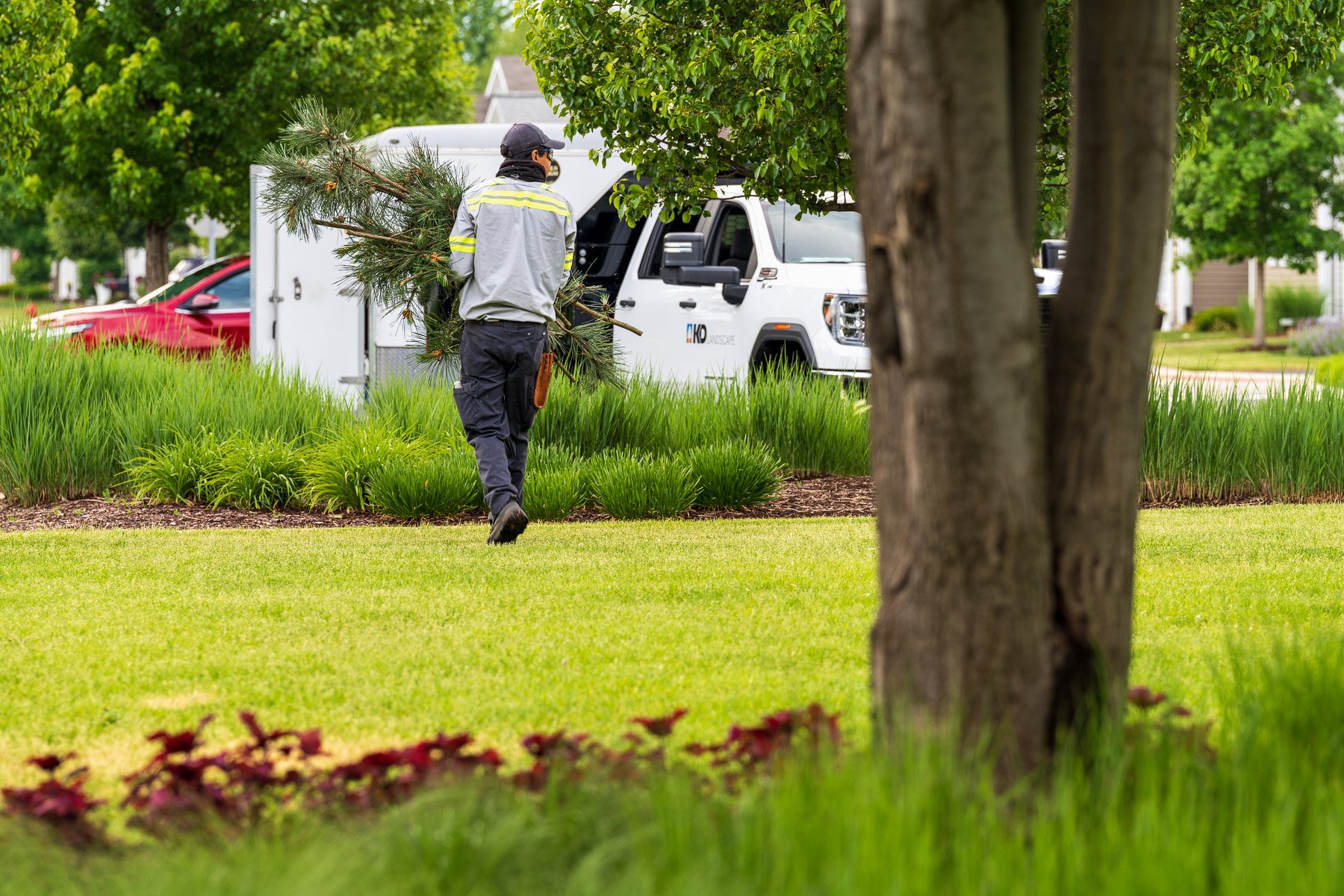
But maybe you have a lot on your plate, and you don’t have time to micromanage a landscape company or worry about whether your property’s trees and shrubs are being neglected by the service provider you chose.
We get it. You’re busy, and your time is valuable. Let KD Landscape help. We can discuss your priorities and build a relationship of trust with you, so you feel like we’re truly listening to your needs for your trees and shrubs.
We can communicate with you and respond promptly to your questions so you’re never left wondering what’s next or if something is not complete. We can proactively share impactful ideas with you to boost areas of your property that you may not have even known needed attention.
Want to learn more about KD Landscape’s commercial landscape maintenance in Chicagoland? Get started today with an on-site consultation. We’ll review your options together so you can make a great choice.





